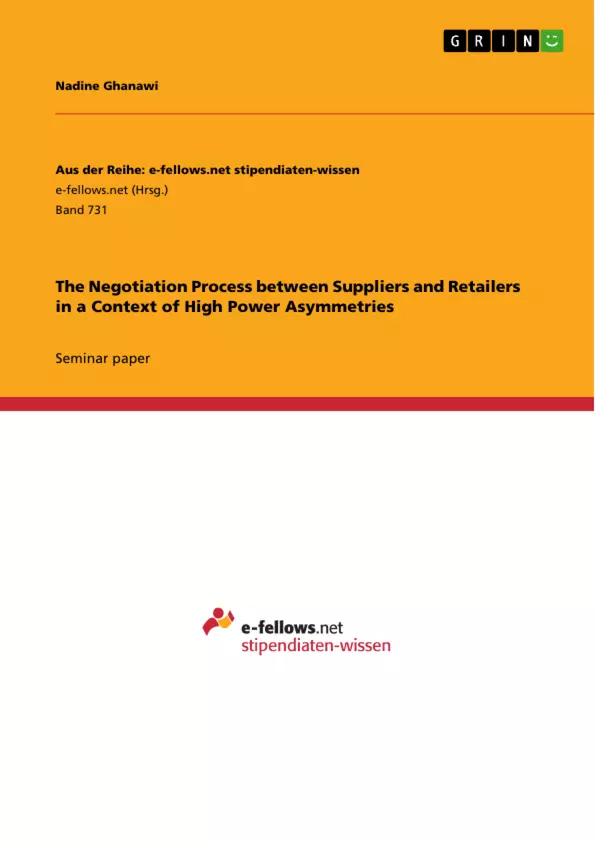A negotiation is generally defined as a process that takes place in “situations in which two or more parties recognize that differences of interest and value exist among them” (Howard 1982, p. 7) and in which they want to seek “optimal, balanced, mutually acceptable and durable solutions of [their] conflicts, problems and projects (Dupont 1996, p. 39). In the business context, negotiations between producers and retailers in particular have been given a great deal of attention in academic literature since the late twentieth century (Lindqvist 1983, Davies 1990, Bolen 2003, Whelan 2009). In fact, those negotiations are vital for establishing the terms of trade, or whether there will be any trading at all (Bolen, 2003).
However, supplier-retailer relationships are usually everything than balanced when it comes to bargaining strength: Developments in the structure of consumer and grocery products supply chains––i.e. the shrinkage of traditional distribution channels and the emergence of hypermarkets as well as specialized retail chains–– have made retailers become sort of “gatekeepers” to the final customers (Hirschman & Stampfl 1980). Since producers wanting to sell their products to the market have to sell them to retailers first, the latter are clearly in a more powerful position not being as dependent on their counterpart as it is typically the case vice versa. Likewise, the role of power in negotiations has been discussed by a number of established authors (see, for instance, Barbarach & Lawler 1980, Zartman & Rubin 1994). Most notably in interactions with large retail chains, the imminent question for small producers is: What happens when you encounter a company such as Wal- Mart, occasionally described as “the ultimate non-negotiable partner” (Hanna 2008)?
Inhaltsverzeichnis (Table of Contents)
- Introduction
- Supplier‐Retailer Relationships in Negotiations
- The Exchange of Information
- Finding the Lowest Common Denominator
- Case Study Analysis – Negotiating with Wal‐Mart
- Background
- Actor Analysis
- The Retailer’s Position – The Power to Make or Break
- The Supplier’s Position – Homegrown Freshness
- Structure and Context
- Negotiation Strategy and Process
- Key Findings and Negotiation Principles
Zielsetzung und Themenschwerpunkte (Objectives and Key Themes)
This paper analyzes the negotiation process between suppliers and retailers in a context of high power asymmetries, focusing on the example of Frey Farms' negotiations with Wal-Mart. It aims to understand how small suppliers can successfully navigate these power dynamics and achieve mutually beneficial outcomes.
- The role of power dynamics in supplier-retailer negotiations
- Strategies for small suppliers to overcome power imbalances
- The importance of understanding the retailer's true interests and values
- The impact of negotiation structure and context on the outcome
- Key negotiation principles for achieving win-win outcomes in asymmetric power situations
Zusammenfassung der Kapitel (Chapter Summaries)
The Introduction sets the stage by defining negotiation and highlighting the importance of supplier-retailer relationships, particularly in light of power asymmetries in the retail landscape. It introduces the case study of Frey Farms and Wal-Mart, which demonstrates how a small supplier can effectively negotiate with a powerful retailer.
Chapter 2 provides an overview of supplier-retailer relationships in negotiations, focusing on the exchange of information and the concept of the Zone of Possible Agreement (ZOPA). It discusses the impact of power dynamics on information sharing and highlights the need for suppliers to understand their own negotiation space.
Chapter 3 delves into the case study of Frey Farms and Wal-Mart. It presents a detailed analysis of the actors, their interests, and the negotiation context, including the impact of Wal-Mart's EDLP policy on the supplier's position. It analyzes the structure and context of the negotiations, demonstrating how changing market conditions can impact negotiation dynamics and create opportunities for small suppliers.
Chapter 3 also examines the negotiation strategy and process employed by Frey Farms. It highlights the importance of understanding the retailer's true interests, employing integrative tactics, and establishing a favorable negotiation structure. The chapter discusses how Frey Farms' successful negotiation tactics led to mutually beneficial outcomes for both parties.
Chapter 4 presents key findings and negotiation principles derived from the case study analysis. It emphasizes the importance of actor analysis, establishing a negotiation formula, using integrative tactics, and creating a favorable negotiation structure. The chapter concludes by highlighting the importance of empathy, tact, and partnership-focused approaches for small suppliers in high-power situations.
Schlüsselwörter (Keywords)
The main keywords and focus topics of the text include supplier-retailer relationships, negotiation process, power asymmetries, negotiation strategies, integrative tactics, ZOPA, BATNA, Wal-Mart, Frey Farms, EDLP policy, case study analysis, and negotiation principles.
- Quote paper
- International Master of Business Administration Nadine Ghanawi (Author), 2013, The Negotiation Process between Suppliers and Retailers in a Context of High Power Asymmetries, Munich, GRIN Verlag, https://www.grin.com/document/229419



